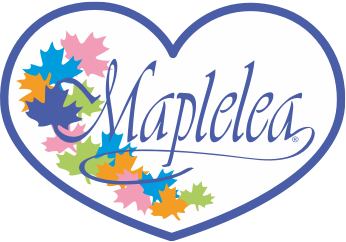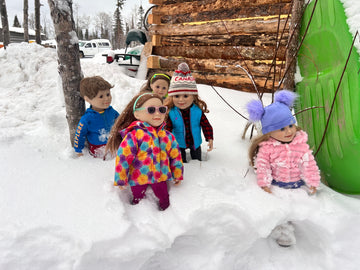The following is an article that was featured in "Delivering the Online World" Magazine, Fall 2018 Edition.
How does a homegrown pure play take on an American giant? By doing the one thing that giant can’t – be unabashedly Canadian!

For Kathryn Gallagher Morton the doll business has never been more challenging.
As president of Avonlea Traditions Inc., maker of the Maplelea dolls, she’s fighting both for mindshare of girls in a digital era and for more marketshare of a global omni-channel toy industry. But what may be most challenging is finding a way every day to slay a U.S. giant that dominates the battle of the 18-inch dolls – the mighty and ubiquitous American Girl.
Owned by Mattel, American Girl has a hefty line of physical stores, enough money to produce books, movies and digital games, and a massive marketing budget that should render a relatively small Canadian pure play powerless to compete. But compete it does.
So how does Maplelea hold its own against this Goliath? In a few smart ways.
Competing with giants.
The Newmarket, Ont.-based company diligently keeps its prices lower than American Girl, while also ensuring the quality of its products is higher – from the dolls to the fabric of their clothing. But mostly, it differentiates itself by fully embracing its Canadian-ness.
“Canadian companies make their toys generic, which enables them to sell to that larger, international market,” says Morton. “That leaves our kids with few playthings that reflect our history, geography and culture. But there are a lot of parents who want to have something for their children that is Canadian, not American.”
Maplelea targets those parents when designing its products. For instance, the seven core Maplelea dolls each come with journals filled with elaborate stories set in their hometowns – from urban Toronto to far-afield Nunavut – along with local places, landmarks and maps of Canada. The line of accessories include some uniquely Canadian items, such as wooden toboggans, parkas – with insulating layers and flaps that cover the zippers – and hockey gear.
The authentic Canadian themes and high quality of the products help build customer loyalty, which has been a major source of spreading brand awareness. “We don’t have a huge marketing budget,” says Morton. “I can’t tell you how important word-of-mouth advertising is for us.” Word of mouth – and catalogues.
Catalogues to the rescue
When Morton launched Maplelea 15 years ago, she sought to get the dolls into independent toy stores, where customers are more willing to pay a higher price in exchange for quality. However, it wasn’t working. Before calling it quits, she tried a last option. She printed a paper catalogue and poly-bagged it with the popular kids’ magazine Chickadee, so people could read the Maplelea story right in their homes and see the extent of the line.
“As soon as the paper catalogue hit, the phones lit up. We were getting orders from every city and rural town in Canada.”
With the advent of e-commerce, the growing Maplelea team launched a sales channel on its website, where, in order to protect margins, the product line is now sold exclusively. It offers its online customers a convenient checkout experience, including showing upfront shipping prices, choice of delivery carriers and delivery dates. It also recently switched to Shopify for its platform, which has enabled it to more easily control and update the robust content on its site.
It has also expanded its initial catalogue strategy, placing catalogues in more kids’ magazines, as well as in doctors’ and dentists’ offices where mothers are likely to work and visit, and directly in customers’ mailboxes. Even in the digital era, the catalogue reigns supreme. “Paper catalogues remain the backbone of our marketing program,” says Morton. “We have incorporated digital – but you can blow through a lot of money on a digital campaign. It can cost $1/$1.50 when someone just clicks on an ad. Yet for about the same amount, I can get a catalogue into their home where it gets held and read. It stays around far longer than a digital ad.”
 |
Unique doll accessories help build loyalty among parents who want to buy their children playthings that reflect Canada’s story; the Newmarket, Ont., warehouse is filled with Maplelea’s blue branded packaging that kids instantly recognize. |
Digital foes and friends
Of course the digital era is creating challenges beyond marketing strategies. It’s posing real existential questions for traditional toy companies serving kids who are becoming more tech and social media savvy. However, Morton also sees unexpected opportunities from the digital era. She credits it for extending the life cycle of the dolls as teens are now using them as characters in stop-action movies and elaborate Instagram scenes. “We want to be that alternative where girls use their imagination and play in the real world with a tangible object,” says Morton. “Now, they’re doing something in the real world and then showing it off in the digital world.”
When it comes to what’s next for Maplelea, Morton says she’s staying the course. “The product doesn’t need to change,” she says. “But the girls can change how they use it. That’s the remarkable thing about a doll.”






I love when you did lots of detail on the faces and eyes their beautiful! And I’am glad that you add pets they are so cute!
I have just bought a 2003 Taryn who is the first Mapelea Girl I ever saw and was smitten, but could not afford. Her limbs are a bit loose, but I have a doll stand for her. She is sweet and came in a beautifully made outfit. She joins Saila and Alexi on my bookcase. Thank you for the high quality of these dolls.
I Love my Charlsea doll she is the best doll ever💖💖💖she looks just like me👱🏼♀️👩🏼👱🏼♀️Love your dolls make more!!!!!!!!!!!!!
i love all your dolls so much, i love how you pay attention to detail in all the dolls they are all so well made and i am very happy with my two dolls Jenna and leonine i also love reading your magazine and look froward to read the next one. thank you to everyone at maplelea
My first purchase was Charlsea and full winter gear. I was surprised of their amazingly good quality. These dolls are wonderful and diverse. I would recommend them to anyone.